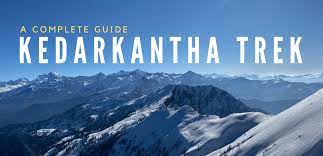Winter hikes are unique in a few ways.
To find out what?
The actual SNOW.
Surprised?
Let’s picture a fantasy landscape like to what you saw in the movie “Frozen”: a camphor-white snow mattress covering the entire landscape, a wild forest of pine, oak, and deodar trees, and some summit vistas that will steal words from the most accomplished writer. The most well-known winter trip in India is the Kedarkantha Trek, which is what we’re referring to.
In actuality, it gives you more than you had anticipated. Winter is the greatest time to go on this trek, though. It may be done year-round (except during the monsoon). This thorough Kedarkantha trek guide for 2023 will reveal a number of arguments in support of the assertion that it is the best winter trek.
Quick Facts:
· Location: Uttarakhand
· Height: 3800 Meters
· Duration: 6 Days
· Trek length: 20Km
· Difficulty level: Easy to Moderate
· Starting Point: Sankri
· Ending Point: Sankri
· Base Camp: Sankri
· Nearest Place with Pan-India Connectivity: Dehradun
· Weather: The warmest months for this walk are May and June, when the minimum and maximum temperatures respectively average 5-7 and 15-20 degrees. Temperatures in the winter range from below zero to nine degrees.
Ideal Season to Travel to Kedarkantha Trek
Every season, with the exception of the monsoon, is open for the Kedarkantha Trek. The walk offers views of various types of nature throughout the summer (May–June), fall (September–October), winter (November–February), and spring (March–April).
As the temperature varies from 7 to 20 degrees, the summer is generally more comfortable. Summer is characterized by somewhat warm days and chilly evenings. The clearings and forests are vibrantly colored and lushly verdant with flowers. The climb to the summit is simpler.
Difficulty Level
Depending on a person’s level of physical fitness and endurance, the Kedarkantha journey might be easy or moderate.
Although there are some hard rising sections along the trail, the terrain and approach to the peak are gradual. One must travel 20 kilometres in five days and climb from 1950 metres to 3800 metres over the course of almost a week. This entails walking 4-5 kilometres on average each day and rising roughly 300 metres.
These numbers show that it is slow-paced. And allows for adequate acclimatization compared to other hikes. Without a doubt, those who are physically fit enough can complete this task with ease.
Kedarkantha Trek Itinerary
Day 1
● Your true experience will start from Dehradun, which you may get to for this hike via train or flight. You will arrive at Sankri after a 210 km drive via a winding mountain road.
● It normally takes 10 to 11 hours to complete this excursion while taking in the stunning scenery.
● After arriving in Sankri in the evening, your day will come to a conclusion. You will spend the night at a local homestay.
Day 2
● You will depart Sankri at daybreak on the second day and begin walking down the neighborhood route that goes to the neighbouring forest.
● This section alternates between being hilly and being flat and easy to walk.
● You will arrive at Juda Ka Talab, an alpine lake and our campground for the day, after hiking for 4 km and 5 hours.
Day 3
● The spectacular Dhauladhar range is the destination of today’s trip through the forest close to Juda Ka Talab.
● You will walk for two to three hours across a 4 km area of deep forest.
● You will arrive at an open meadow at the foot of the summit as you near the end of our forest walk.You experience this when you are 3500 metres above sea level.
● The most breathtaking view of. The entire hike may be found from this clearing. You will see more impressive peaks of the Dhauladhar ranges, including the Kedarkantha peak a few kilometres away, all staring at you.
Day 4
● The hardest but most rewarding day will be Day 4.You will begin your ascent of the Kedarkantha peak’s top by ascending a difficult ridge starting from the base camp at the peak’s foothill.
● When you finally reach the peak’s summit, the altitude has increased to 3800 metres from the previous elevation of 3500 metres. When you get back to Hargaon, the elevation drops to 2700 metres once more.
● You will return to the basecamp, where you spent the previous night and began today’s adventure, after reaching the summit. After eating there for lunch, you’ll go to Hargaon, where you’ll arrive by evening.
● It is a 6-7 km excursion that will take you roughly 7 hours to complete.
Day 5
● You will use the same forest trail that you used to travel from Hargaon to Sankri today.
● The hike today just required 4 hours of walking, so it was rather simple. On this day, 6 kilometres will be travelled.
● You’ll spend the remainder of the day in the guest house when you get back to Sankri.
Day 6
You will be transported back to. Dehradun on this final day. The same beautiful route that you used to get to Sankri will be your route when you drive.
Conclusion
In conclusion, Kedarkantha can be categorized as a distinctive journey. This walk stands out from others due to its diverse landscape, easy to moderate difficulty (It’s RARE! ), practically year-round activity on the trail, amazing 360-degree views from the peak, and other features.If you go to Kedarkantha in the winter, you’ll see snowfall, frozen lakes, and snowdrifts that look much like pricey Christmas decorations. These are extras in addition to the previously mentioned highlights of the trek throughout other seasons. You now understand why you must go on the Kedarkantha trip during the winter. If you have any plans, we advise going on this walk at least once during the winter.





